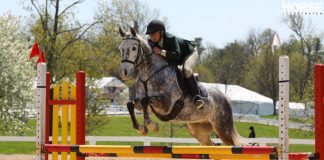 |
| Denice Klinger and Lido competing in a hunter breeding class. Photo courtesy picsofyou.com. |
It seems like western breeds get all the breaks when it comes to logging show miles at an early age. Endless halter, showmanship and longe line classes get babies exposed to the sights and sounds of competition. By the time they’re under saddle they’re unrattled by a warm-up ring full of unfamiliar horses and the crackling of the PA system. But with the growing popularity of hunter breeding classes and in-hand classes specifically designed for prospective hunters, English riders have opportunities to get their babies in the show ring, too.
“Conformation and movement are very important, but what is often overlooked is suitability, which is the same as type,” explains Denice Klinger, a longtime hunter competitor who has been showing youngsters in hunter breeding classes on the east coast for over six years. “Type means that the horse looks like his breed standard or, in the case of hunter breeding, exhibits suitability for the job.” Before contemplating showing your horse in this division, she says to seriously ask yourself, “Does he look like a hunter?”
Denice is currently showing her own 2-year-old, a flashy chestnut Thoroughbred gelding nicknamed Lido that she handpicked for the hunter division off a farm in Florida. An added benefit of showing Lido in-hand is that he has become indoctrinated to the show routine at an early age. In order to perform he has to perfect his ground manners. Much like any halter class, protocol requires that each horse is stood up for the judge, then walked and trotted to display movement. According to Denice, that means the young horse must understand that, “Whoa means stop, stand still,” not pause and then walk into the human. You also have to discipline your horse not to play or become rambunctious when he trots, because he has to trot alongside you on a loose rein in order to strut his stuff for the judge.
With that in mind, Denice warns, “If the judge can’t see your horse because he spends more time on his hind legs than trotting, or never stands still, then how can he or she fairly judge your horse? I can’t blame them if they don’t try too hard especially if your horse is the lone idiot. And trust me, I’ve been there, done that over the years!” Fortunately she adds that judges are pretty sympathetic. “Exceptions are generally made for the younger horses. It’s understood early in the year that no yearling has had any practice. But 2-year-olds, especially late in the show season, and all 3-year-olds should stand up and behave.”
The young hunter’s turnout is vitally important. Braiding is essential. It dresses up a young hunter’s topline, and there’s no way to hide a ewe neck or camouflage a thick throatlatch with a bushy, unkempt mane. All horses, even yearlings, must also be presented in a snaffle bridle, complete with a pair of laced reins. The bridle should be of traditional hunter-type, not a dressage or sport horse bridle with a flash attachment, padded noseband or decorated browband. Just think classic and simple brown leather, and make sure the bridle fits the horse properly.
Fortunately, the turnout for handlers is not quite as regimented. Hunter handlers can be far more casual than their western breed counterparts in their splashy tunics and jackets.







Sounds fun! Thanks for all the informative articles. 🙂
wow that is great!
Great idea.
Good advice. Thanks.
This sounds interesting
Glad I’m not the only one showing my baby hunter in halter classes!
I am new to showing english horses, and am so excited! I am in the process of purchasing a weanling Hanoverian colt, and have been trying so hard to figure out how we will start our show career! It is harder than one would think learning how to get young english horses involved in the show ring! This has by far been the most helpful, understandable peice I have come across! Thank you!
I think making you show a yearling in a bridle is a mistake, so my guy will not go until he is 2. The sport horse breed shows let you show in a halter, which is more appropriate for a yearling.